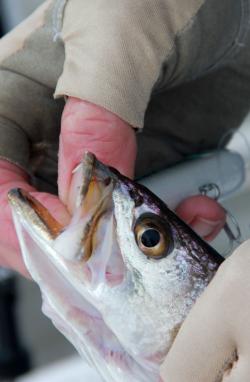Summer Topwater Trout
By William Redmond
from The Fishing Wire
They could very well be one of the most underrated of Florida’s sport fish. Lacking the sturdiness of a snook or redfish, speckled trout are known for their soft bodies and paper thin mouths, but once these fish reach about 24 inches, they earn the nickname “gator trout” for an undeniable ferocity most clearly displayed in their treatment of topwater plugs.
From a boat or on foot, casting surface plugs for speckled trout ranks as one of the most popular angling pursuits for shallow water anglers throughout the Sunshine State’s Gulf Coast region. Capt. Jason Stock, who guides from a flats skiff and a kayak, knows well the trout’s penchant for attacking topwaters. For him, the entertainment value is tough to beat.
“It’s so visually exciting,” Stock said. “When they pop it, there’s no question. He may blast it, miss it and come right back for it again.”
The venerable Heddon Spook, in nearly any size, can be a seatrout killer in summer.Stock’s a fan of Heddon topwaters – typically the Spook Junior in calm conditions and a One Knocker Spook when a summer breeze puts a little motion on the ocean and requires an audible trail to help the trout track their target. A 7- to 7 ½-foot medium- action spinning outfit with 25-pound braid and a 20- to 30-pound fluorocarbon leader will handle even the 7-pound-plus monsters. At any size, Stock said, trout are crafty fish, so seamless attention is a must.
“Be ready, because they might hit at the end of a long cast,” he said.
Trout are widely dispersed throughout Florida’s coastal environments, but Stock has three favorite scenarios:
Daybreak
Easing up to island edges or onto the top of a skinny grass flat just as the sun starts to “pink out” the sky, Stock expects to find big trout hunting finger mullet, sardines and anything else they can catch in a foot or so of water. Dimpling pods of bait are a sure sign, as the food source won’t go overlooked by hungry trout.
Stealth is a must in this shallow habitat, as big trout are keenly aware of their vulnerability to porpoises and ospreys. Here, especially, long rods and thin-diameter braid play essential roles in achieving the long casts needed to reach these fish from a distance they can tolerate.
Note: Minimize your movement in a boat, as pressure wakes will alert the perceptive trout. Likewise, wade with soft, sliding steps rather than a noisy, stomping pace that sounds like thunder beneath the surface.
For either Spook model, Stock likes the bone, chrome and black/gold colors. It’s the same for the new 3 ½-inch Chug’n Spook Jr., which creates more surface commotion while still retaining the ability to do the classic walk-the-dog retrieve. Stock often employs a slow, steady retrieve with a 1-2-3, 1-2-3 cadence that produces the enticing walk-the-dog action. Resembling a wayward finger mullet, this Spook display will draw some of the most indescribably violent strikes you’ll ever see.
When it’s on, this shallow water trout bite will have you begging the sun to delay its ascent, but once the big orange ball rises high enough to start warming the meager depths, the daybreak madness quickly wanes and it’s time to move on to Scenario Number 2.
Midday
During the heat of midday, anglers often ditch their trout pursuits and turn their attention elsewhere. Stock, however, knows that trout don’t depart the area – they simply relocate. In most cases, the fish will move away from the shallow flats and slip off the outer edges of adjacent bars.
Settling into potholes and grassy trenches in the 4- to 6-foot range, the fish usually require a little more coaxing before they’ll venture topside. This is where the One Knocker and the Chug’n Spook really shine, as this low-pitch rattle speaks to the trout’s belly and the added surface disturbance makes the lure easier to locate and track.
Tidal movement always benefits predators with food delivery, but incoming cycles really stimulate summer fish with cooler, oxygenated water. Also, Stock said weather can profoundly influence the midday action.
“Approaching storms will often get the fish going,” he said. “They might chew really good right before the rain comes and then also after the storm because that rain cools the water.”
After Hours
Nighttime offers a twofold benefit for trout anglers. For one thing, lower light reduces visibility and thereby makes the fish more approachable. Moreover, the abundance of dock and bridge lights offer countless targets where Stock finds trout ambushing tide-born crustaceans and baitfish that flow past the illuminated areas.
Topwater trout action is best at dawn and dusk on the flats, but you might also connect at mid-day by fishing the outer edges of flats and bars.A variety of baits work in this scenario and topwaters certainly have their place in the game. Walk a spook past the edge of a dock light and the result may look like someone dropped a coconut into the water.
Of course, the pinnacle of nighttime trout fishing is the full moon phase when the silvery beams bring the dock light affect to the entire coastal region. Anglers are still better concealed than they are pre-sundown, but trout enjoy the cooler feeding period with plenty of visibility for targeting those bait schools. Stock said he uses his ears as much as his eyes to locate the full-moon action.
“You can hear the smaller mullet getting blasted,” he said. “Look where there’s activity, ease in slowly and anchor off the mullet schools. Or, if you’re looking, just drift through the area and fan cast.”
In any of these scenarios, remember that those giant “gator” trout that love Spooks are typically females. Handle these fish with great care and consider releasing your bigger trout. Returning these breeders to their coastal habitat will help perpetuate Florida’s awesome topwater action.

